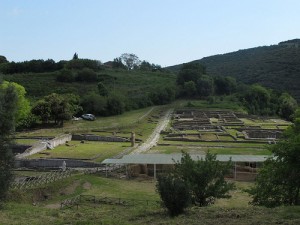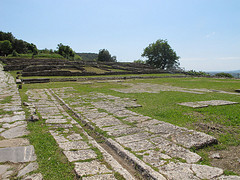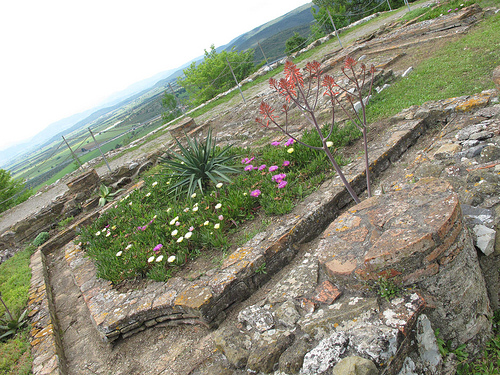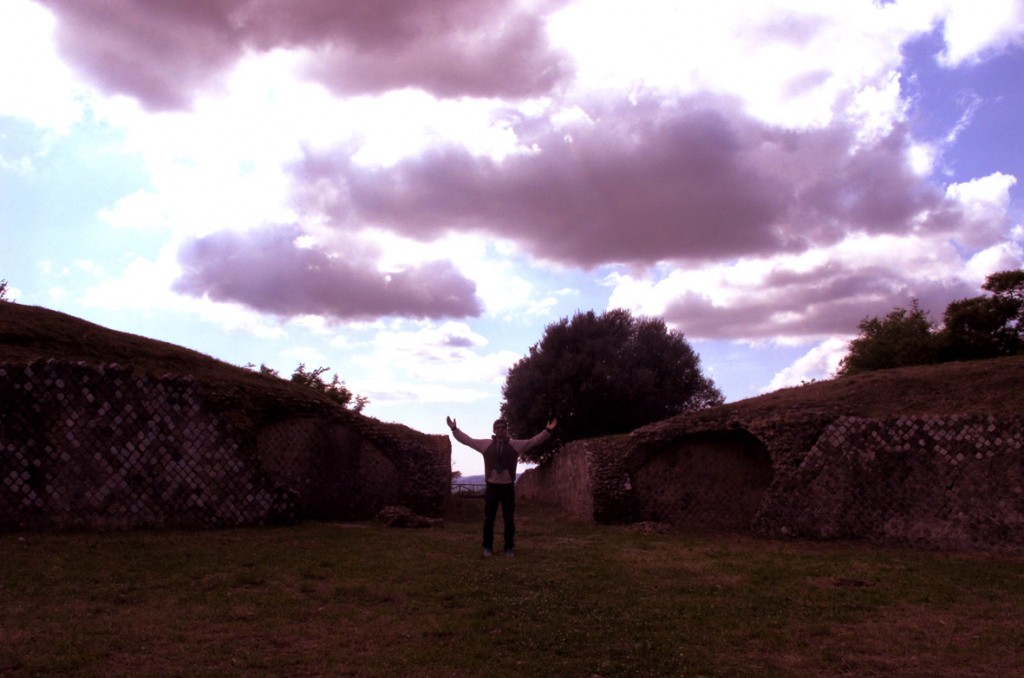 I had a few hours to spare in Maremma last weekend so I decided to visit the archaeological site of Roselle – just for a touch of culture, eh! At Roselle there’s quite a large excavated Roman town with some Etruscan remains; it’s a 1.5 to 2 hour visit and a pleasant walk in a partially wooded area. The weather was coolish and the guide told me that Spring is the best time to visit; in August it gets too hot.
I had a few hours to spare in Maremma last weekend so I decided to visit the archaeological site of Roselle – just for a touch of culture, eh! At Roselle there’s quite a large excavated Roman town with some Etruscan remains; it’s a 1.5 to 2 hour visit and a pleasant walk in a partially wooded area. The weather was coolish and the guide told me that Spring is the best time to visit; in August it gets too hot.
The Etruscan settlement at Roselle in the 7th century BC dominated the Prile Lake that at the time occupied what we see as plains, here at 11km from Grosseto and the coast. It was conquered by the Romans in 294 BC (under Consul Lucius Postumius Megellus, in case you had to know) but this appears to have been a “soft” defeat in that the Romans took 2000 prisoners (according to Livy) but also seems to have assimilated the Etruscans and their buildings. They didn’t expand much on the already largish settlement until the Imperial age, from which time we can now see an amphitheatre, forum, and houses. This land was inhabited until the early 12th century when it was abandoned by Bishopric decree because the area was overly prone to malaria. The church and everyone with it moved to Grosseto. Without layers of subsequent building, it has been relatively easy to excavate the area, although some sections haven’t been fully finished.
What you can see now at Roselle
You start from the visitor center on to a road that leads to the city. The first thing you’ll see is some 4th-century public baths that would have been used by visitors just like you (only dirtier) before arriving into the city center.
 Walking up the Decumanus Maximus you reach the forum (you can see a flat rectangular area with paving stones, see photo). As in all Roman towns, the forum is at the crossroads between the Decumanus and the Cardo, and near it are placed all the most important public buildings, like the Basilica (not much left now), the Curia (where public meetings were held), and other cult buildings.
Walking up the Decumanus Maximus you reach the forum (you can see a flat rectangular area with paving stones, see photo). As in all Roman towns, the forum is at the crossroads between the Decumanus and the Cardo, and near it are placed all the most important public buildings, like the Basilica (not much left now), the Curia (where public meetings were held), and other cult buildings.
A really rich family must have lived in the Domus dei Mosaici, which takes up much of the area just above the forum. A lot of rooms meet off a central courtyard (atrium); it had its own baths with mosaic flooring, and a lovely peristyle (columned courtyard) and garden that overlooks the valley. The garden has been planted with some very sun-loving plants that add suggestive colour to the ruins.
On the lower side of the forum under a white covering is the oldest discovered part of the town, the Etruscan temple. Following the road uphill in the other direction you reach the oval amphitheatre, whose acoustics are great (we tested it) and in which plays and concerts are held in the summer. There is another important public bath not far from here; these are the baths of Hadrian (120 AD), with quite a deep pool and all the accessory rooms around for different temperatures of water as well as beauty treatments that both men and women enjoyed.
On the south side of the hill via an unexcavated road that leads away from the forum there’s a suburban residential area, near which you can also see an impressive cistern used to collect rainwater in the Imperial Roman age – it’s coated with lime mortar which waterproofed the walls and honestly looks like the most modern poured concrete. While these habitations aren’t really that exciting, the path to them was a lot of fun as it’s full of wildflowers and plants. I got some very good photos of thistles and poppies.


